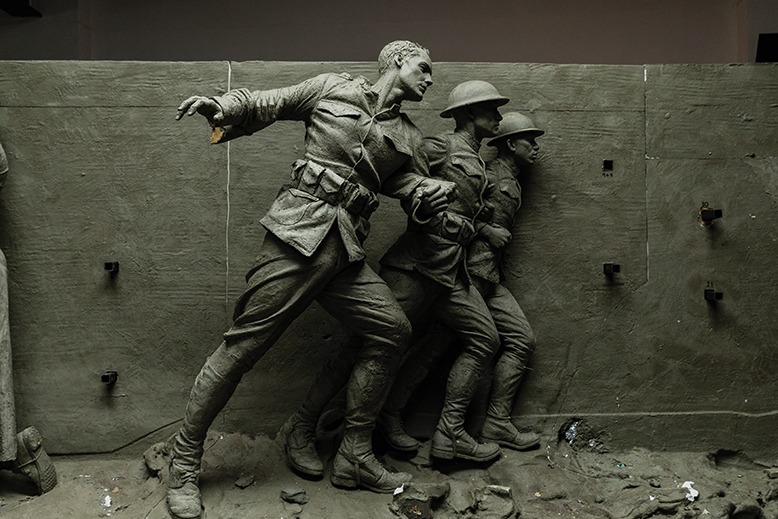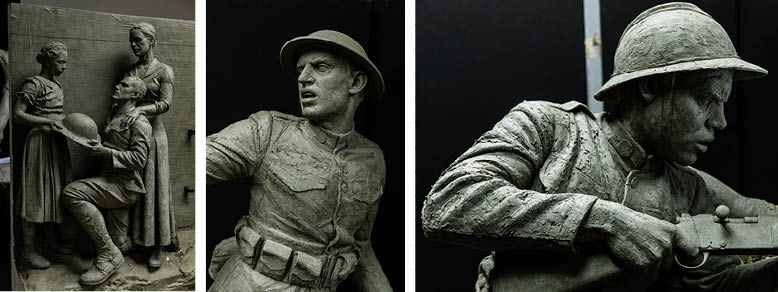
In the completed section of A Soldier’s Journey, the soldier heads into battle with two comrades. Courtesy of Sabin Howard
Behind the soaped window of a former warehouse in downtown Englewood, an epic journey is taking shape. Under a skylight that catches the day’s waning glow, Sabin Howard is carefully applying small swipes of clay to the figure of a soldier in a World War I doughboy’s uniform. Howard’s gaze moves from the sculpture to actor Mark Puchinsky, a live model who looks every inch the young warrior, down to the authentic olive drabs that Howard purchased from World War I reenactors.
The figure, about 10 percent larger than life, is one of 38 that will eventually comprise an intricate, 60-foot-long bronze relief titled A Soldier’s Journey. It will form the centerpiece of the country’s first national World War I memorial, commemorating the 4 million Americans who served in what was once known as the Great War. Chosen out of a field of 360 entries in an international competition, Howard’s piece will be installed in Pershing Park, just steps from the White House, in the fall of 2023 or the following spring.

A scale model hints at the scope of Howard’s epic work. To date, he has completed 10 of the planned 38 figures. Courtesy of Sabin Howard
The uncertain timing reflects the arduousness of Howard’s process. Each figure requires some 600 hours of work, meaning Howard can complete only nine or 10 figures in a year, even with two assistant sculptors and a team of models. Considered a master of modern classicism, Howard, 57, creates sculpture that is startlingly realistic. He is, says project manager Traci Stratton—the novelist/documentarian who is also Howard’s wife—a perfectionist: “If he had 800 hours to complete a work, he’d want 1,600,” she says. “If he had 1,000, he’d want 2,000.”
In fact, the project would literally have taken a lifetime to complete if Howard had followed his traditional routine: creating a drawing of the proposed sculpture, producing a small-scale 3-D maquette (or preliminary model), building foam-covered steel armatures (or frameworks) of each figure, applying clay to the armatures, and then casting the work in bronze. He was able to skip the labor-intensive third step in favor of a digital process in which the armatures are 3-D printed.
The work is a departure for Howard in another significant way. “I had to change from being a strict classicist”—sculpting idealized, largely static forms—“to being an expressive humanist. You can’t have a visceral impact on the viewer with art that’s purely cerebral.”

Far left: The soldier’s daughter hands him his helmet. Center and right: The progression of the struggle. Courtesy of Sabin Howard
Reading from left to right, A Soldier’s Journey depicts one man’s wartime saga, beginning and ending with the soldier’s daughter, who holds his helmet. Along the way, he joins a fierce battle, sees his comrades fall, is buoyed by nurses and returns to his family.
“The sculpture mimics film, going from image to image to image,” Howard says. “It’s very kinetic and emotional.”
To maintain his artistic vision, Howard himself had to become a warrior, battling the bureaucracy—in particular, the Commission of Fine Arts—that presides over public works installed in the nation’s capital. It took 18 iterations of the original drawing, two maquettes and 18 months to get the commission’s approval.
[RELATED: A Jersey Soldier’s Voice Emerges from the Past]
During that process, Howard was asked to make changes that he felt would destroy the integrity of the work. He resisted. “With Traci’s help,” he says, “I took my power back in this project, because the vision was so imperative.”
While A Soldier’s Journey draws on the classical tradition, its point of view renders it strikingly contemporary, such as the way it humanizes, without aggrandizing, battle.
Literally and figuratively, the work is about human interconnectedness. “It’s a piece about war,” Howard says, “but also about healing.”
